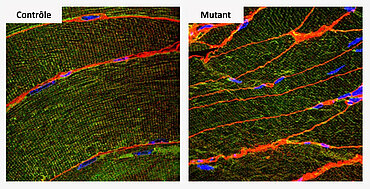Androgen receptor coordinates metabolic and contractile functions of skeletal muscle
Androgens are steroid hormones that affect muscle structure and strength whose action is mediated by the androgen receptor. In a study published in the Journal of Cachexia Sarcopenia and Muscle, the research group coordinated by Dr. Daniel Metzger and Dr. Delphine Duteil characterized the effect of the absence of the androgen receptor in skeletal striated muscle fibers, leading to the development of muscle weakness and type 2 diabetes, and identified the underlying molecular mechanisms.

Androgen receptor is a transcription factor that mediates the effect of androgens. These hormones, essential for sexual differentiation in males, also have anabolic activities and regulate energy balance in mammals. The striated skeletal muscle is a key organ of the energetic metabolism. This tissue, essential for posture and locomotion, is composed of myofibers with different contractile and metabolic properties. In a previous study, scientists from Dr. Daniel Metzger's team at the Institute of Genetics and Molecular and Cellular Biology (IGBMC) established that the structure and strength of limb muscles are altered in the absence of the androgen receptor. However, the impact of the absence of this receptor on metabolism remained to be characterized.
In this article, scientists show that the expression of the androgen receptor increases significantly during puberty. It controls many genes involved in muscle structure and strength, as well as in energy metabolism. Its ablation in skeletal muscle myofibers causes a decrease in glycolytic activity and fatty acid oxidation in muscles, leading to the premature development of type 2 diabetes specifically in male mice. To compensate for these metabolic alterations, amino acid catabolism is increased, generating ammonia and oxidative stress that impacts mitochondrial functions, and leads to necrosis of some muscle fibers.
This study opens the way to the development of androgen receptor ligands with enhanced selective activities. It also allows to clarify the mechanisms involved in pathologies caused by an alteration of the function of the androgen receptor such as Kennedy's disease, characterized by metabolic and structural alterations similar to those observed in the mutant mice characterized by the research team.
At puberty, the expression of the androgen receptor is induced in muscles. Its mutation in skeletal muscle myofibers induces metabolic disorders leading to type 2 diabetes, and structural defects leading to muscle weakness. Credit: Delphine Duteil
